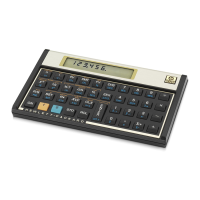62 Section 4: Additional Financial Functions
3. If the initial investment consists of more than one cash flow of the amount
entered in step 2, key in the number of those cash flows, then press ga.
If ga is not pressed, the calculator assumes that N
0
is 1.
4. Key in the amount of the next cash flow, press Þ if that cash flow is
negative, then press gK. If the cash flow amount is zero in the next
period, press 0gK.
5. If the amount entered in step 4 occurs more than once consecutively, key in
the number of times that cash flow amount occurs consecutively, then
press ga. If ga is not pressed, the calculator assumes that N
j
is 1
for the CF
j
just entered.
6. Repeat steps 4 and 5 for each CF
j
and N
j
until all cash flows have been
entered.
With the amounts of the cash flows and the number of times they occur
consecutively stored in the calculator, NPV can be calculated by entering the
interest rate and pressing fl, just as described earlier.
Example: An investor has an opportunity to purchase a piece of property for
$79,000; and he would like a 13½% return. He expects to be able to sell it after
10 years for $100,000 and anticipates the yearly cash flows shown in the table
below:
Since two cash flow amounts ($10,000 and $9,000) are repeated consecutively,
we can minimize the number of storage registers required by using the method
just described.
Year Cash Flow Year Cash Flow
1
2
3
4
5
$14,000
$11,000
$10,000
$10,000
$10,000
6
7
8
9
10
$9,100
$9,000
$9,000
$4,500
$100,000
Keystrokes Display
fCLEARH
0.00
Clears financial and storage
registers.
79000ÞgJ
–79,000.00
Initial investment (with minus sign
for a negative cash flow).
14000gK
14,000.00
First cash flow amount
11000gK
11,000.00
Next cash flow amount.
10000gK
10,000.00
Next cash flow amount.

